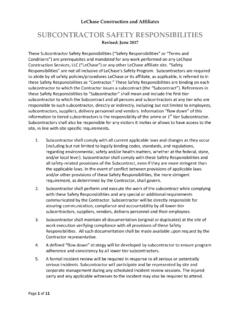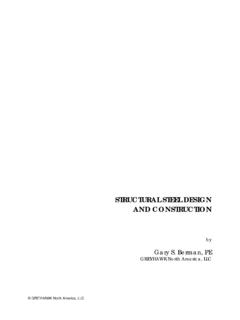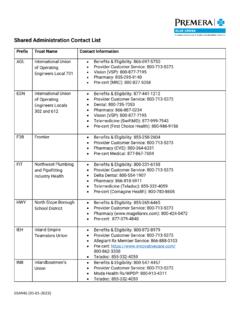Transcription of LAYOUT DRAFTING & PATTERN MAKING
1 LAYOUT DRAFTING & PATTERN MAKING for Insulators Page 1 _____ LAYOUT DRAFTING & PATTERN MAKING FOR HEAT & FROST INSULATORS Hans Siebert APPRENTICE WORK BOOK & JOURNEYMAN REVIEW MANUAL Hans Siebert-2000 _____ LAYOUT DRAFTING & PATTERN MAKING for Insulators Page 2 Preface This book has been prepared as a text for use in Heat and Frost Insulator apprenticeship classes. It explains basic methods of drawing patterns for developing sheet metal and other types of protective covers commonly produced for wrap over insulation.
2 The book does not attempt to teach field work-practices or any application methods used in the trade. Learning how to crimp, bead, seam, rivet and apply materials is best accomplished on the job, not from studying a book. However, for the limited purpose of PATTERN development, this book meets every requirement of an apprenticeship textbook and is, in addition, also well adapted for reference use by journeymen, foremen, and pre-fabrication workers engaged in the designing and/or laying out patterns .
3 The instructions are easy to follow with numerous practical problems that can be completed straightforwardly and worked without elaborate collections of tools or equipment. The subject-matter deals with common trade problems and the specific methods of presenting the assignments are the result of many years of teaching in apprenticeship classes as well as practical experience gained in the asbestos worker trade. The format of the book assumes sequential completion of tasks, especially regarding the preparatory work of practicing drawing principles.
4 For the novice, later work in the book assumes knowledge gained in prior effort. For students with prior knowledge many of the projects can be completed without a drawn-out effort on the study of groundwork. The descriptions are clear and well organized and step-by-step. They stimulate the student to think and reason on his or her own volition as well as simplify the instructor's participation. The work is so planned that the student can work through assignments without arduous direction and tedious supervision.
5 Numerous illustrative problems are distributed throughout the text. The selected assignments and examples are representative of the kind of problems a worker faces on the job and they serve to enable the mechanic to apply knowledge to new-fangled and uncommon situations. Finally, no new material is to be found in this book. Although, I have drawn all illustrations myself, the described projects have been scraped together from various sources in the building trades, including from manuscripts and books used in the asbestos workers, sheet metal workers and ironworkers trades.
6 Additionally, ideas for the projects have been collected from apprenticeship programs throughout the industry. Any and all such contributions are thankfully acknowledged. Hans Siebert October 2000 LAYOUT DRAFTING & PATTERN MAKING for Insulators Page 3 Table of Contents Drawing Principles Equipment, Tools, Preparations 5 Practice Problems in Drawing Bisect Straight Line 8 Erect Perpendiculars 9 Erect Perpendiculars (Method 2) 10 Erect Perpendiculars (Method 3)
7 11 Draw Parallel Line 12 Circle Properties 13 Draw Tangent 14 Bisect Angle 15 Draw Equilateral Triangle 16 Copy an Angle 17 Copy a Triangle 18 Copy an Irregular Figure 19 Construct a Square with Side Given 20 Construct a Pentagon (Method 1) 21 Construct a Pentagon (Method 2) 22 Construct a Hexagon 23 Construct an Octagon (Method 1) 24 Construct an Octagon (Method 2) 25 Construct an Octagon (Method 3) 26 Draw a Circle Through Points 27 Find Center of Circle 28 Describe Segment of Circle 29 Inscribe Triangle into Circle 30 Inscribe Circle into Triangle 31 Draw an Ellipse 32 Draw an Approximate Ellipse 33 Draw an Approximate Ellipse (Method 2)
8 34 Draw an Ellipse by Intersecting Lines 35 Draw an Egg-shaped Oval 36 Draw an Ellipse with Pencil and Thread 37 Draw a Parabola 38 Draw a Hyperbola 39 Draw a Spiral 40 Draw a Helix 41 Divide a Straight Line into Equal Parts (Method 1) 42 Divide a Straight Line into Equal Parts (Method 2) 43 Continued LAYOUT DRAFTING & PATTERN MAKING for Insulators Page 4 Practice Problems in PATTERN Development Introduction to Developments 44 Closed Box 45 Open Box 46 Square Prism 47 Tetrahedron 48 Octahedron 49 Dodecahedron 50 Icosahedron 51 Dovetail Seam 52 Metal Over Tees (Field Method) 53 Non-reducing Tee LAYOUT 55 90-Degree Bend 57 Gores for Bends (Field Method)
9 59 Gores for Bends (Development Method) 64 Gores for Bends (Analytical Method) 65 Non-reducing Lateral at any Angle 73 Reducing Tee at 90 Degrees 75 Reducing Lateral at any Angle 77 Cone 79 Truncated Cone (Transition) 81 Spheres 83 Lunes for Spheres (Head Gores) 84 Lunes for Spherical Tank Head 86 Cylindrical Tank with Rounded Head (Analytical Method) 88 Rounded Head Lunes (Shortcut Method) 91 Round Taper (Off Center) 92 Round Taper (One Side Straight) 93 35-Degree Conical End Cap 94 Square to Square 95 Square to Round 97 Butterfly LAYOUT 99 Table of Decimal to Fraction Conversions 100 Table of Natural Trigonometric Functions 101 Practice Problems for Advanced Studies 103-121 LAYOUT DRAFTING & PATTERN MAKING for Insulators Page 5 Geometric Construction DRAWING PRINCIPLES DRAWING EQUIPMENT Equipment.
10 The following list comprises the equipment required for a course in sheet-metal PATTERN DRAFTING : Drawing board, 24" x 30", T-square, 30"; 45 triangle, 10 ; 30 x 60 triangle, 10"; architect's scale, 12"; 4H drawing pencil; pencil erasing rubber; thumb tacks; detail paper; also a set of drawing instruments consisting of the following items: 5" dividers, 5 1/2" compasses, 3" bow spacers, 3" bow pencil, ruling pen, bow pen and irregular curves. Paper. The paper generally used for sheet-metal PATTERN DRAFTING is known as brown detail paper.






